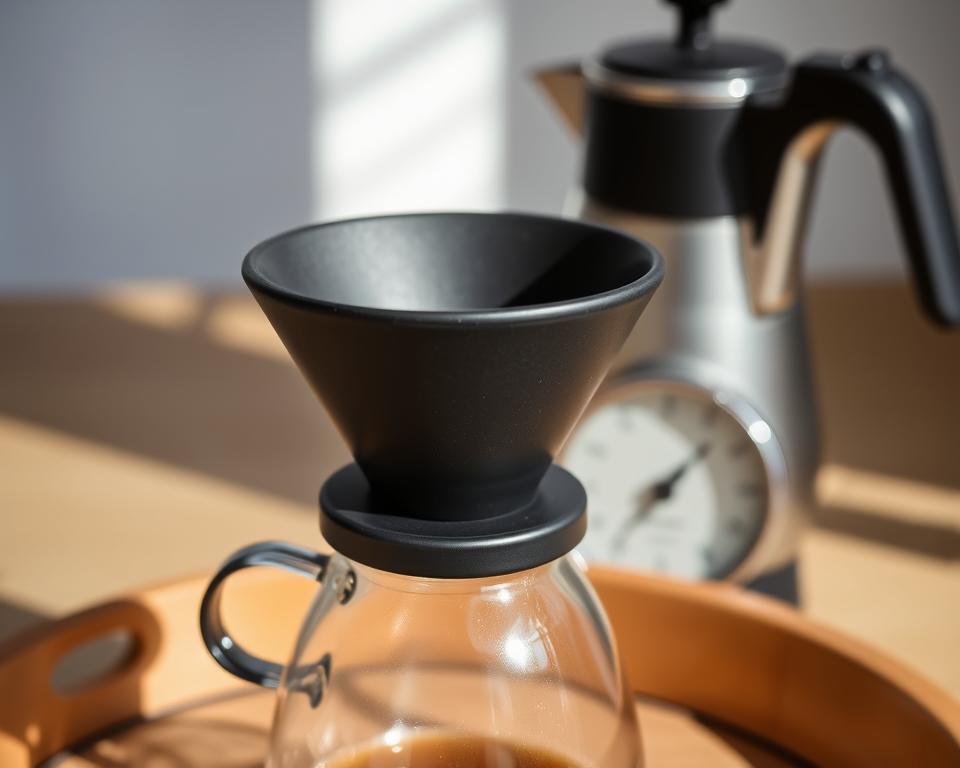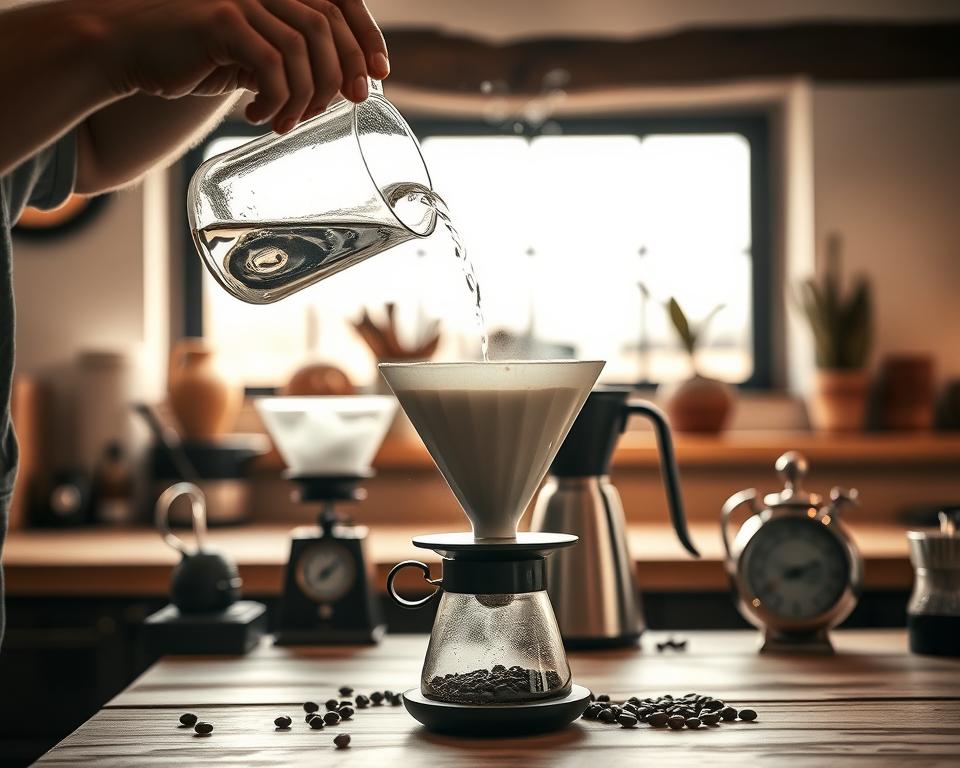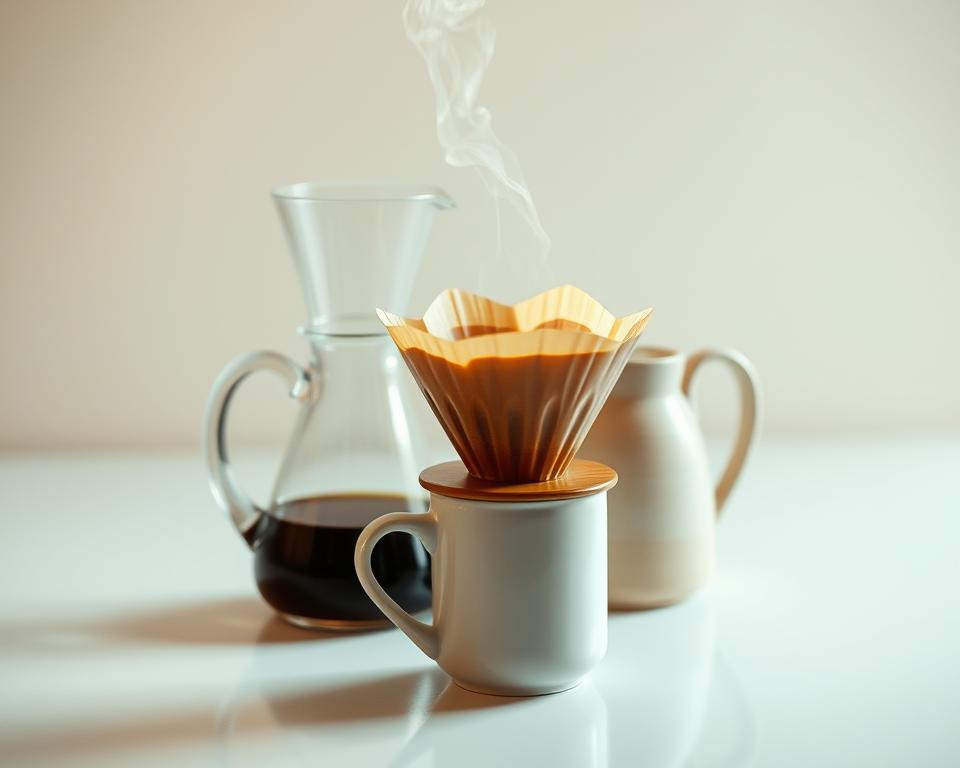The blooming phase in pour-over coffee is a critical step that significantly impacts the brew’s quality. It involves allowing the coffee grounds to release their trapped gases. This results in a more even extraction and a better-tasting coffee. For more information on the blooming phase, visit pour-over coffee brewing guides. Understanding this phase is key to perfecting your pour-over coffee brew.
Key Takeaways
- The blooming phase is a critical step in pour-over coffee brewing that enhances flavor and aroma.
- It involves adding about double the weight of coffee in water to the grounds and letting them sit for 30-45 seconds.
- The recommended coffee-to-water ratio for pour-over brewing is between 1:14 and 1:20.
- Freshly roasted coffee can lose a significant amount of CO2 within one day of being opened, impacting the brewing process.
- Optimal brewing water temperature for pour-over coffee ranges from 195°F to 205°F.
- Pre-wetting coffee filters can remove unwanted papery tastes and improve the overall flavor of the brew.
What is the Blooming Phase in Pour-Over Coffee?
The blooming phase is a critical step in pour-over coffee brewing. It allows coffee grounds to release trapped gases, mainly carbon dioxide. This step is vital for balanced extraction, ensuring water flows evenly through the grounds for a more flavorful cup. Understanding the role of carbon dioxide in this process is key.
Experts recommend brewing water between 92 and 96 degrees Celsius for optimal blooming. The blooming coffee process releases carbon dioxide from the grounds, produced during roasting. This release is crucial for extracting flavors and oils, making it essential in coffee brewing.
Several factors influence the blooming phase. These include the coffee-to-water ratio, water temperature, and grind size. A common ratio is 1:16, with 1 gram of coffee for every 16 ml of water. Grind size affects the bloom, with coarse grinds leading to a gradual bloom and finer ones to an immediate, energetic bloom. The pour-over technique also plays a role, with slow pouring recommended for even distribution.
By grasping the importance of the blooming phase and mastering it, coffee enthusiasts can enhance their pour-over coffee’s flavor and quality. This phase is a cornerstone of coffee brewing, and perfecting it can elevate brewing skills. It ensures a perfect cup of coffee every time.
Why Blooming is Essential for Flavor Extraction
The blooming phase is a crucial step in the coffee brewing process, crucial for pour-over methods. It allows the coffee grounds to release trapped gases and oils. This results in a more balanced and flavorful cup. The ideal water temperature for blooming is between 195 and 205 degrees Fahrenheit. This temperature helps extract the optimal flavors and oils from the coffee grounds.
During blooming, the coffee grounds foam and swell for about 30 seconds to 1 minute after hot water is added. This process is vital for releasing trapped carbon dioxide in the coffee beans. It affects the flavor extraction. A minimum of 30 seconds of blooming is recommended for optimal flavor extraction. The coffee brewing method also impacts the effectiveness of the blooming phase. Pour-over methods rely heavily on this phase for even saturation and flavor optimization.
Some key factors to consider when blooming coffee include:
* Using fresh, high-quality coffee beans
* Maintaining the ideal pour-over water temperature
* Allowing the coffee grounds to bloom for the optimal amount of time
* Using the right coffee-to-water ratio
By following these guidelines and incorporating the blooming phase into your coffee brewing routine, you can enhance the flavor and aroma of your pour-over coffee. Enjoy a more balanced and satisfying cup.
How to Properly Execute the Blooming Phase
Mastering the pour-over coffee process requires a deep understanding of the blooming phase. This step is crucial for releasing trapped gases from the coffee grounds. It leads to a more flavorful and balanced cup of coffee.
The blooming phase should last about 30-45 seconds. During this time, the coffee grounds need to be fully saturated with water. This allows them to release their trapped gases. It’s vital for preventing channeling and ensuring even extraction. To bloom correctly, use the right amount of water and pour it in a circular motion.
Here are some best practices for pour-over techniques:
- Use fresh, high-quality coffee beans to ensure optimal flavor extraction.
- Use the right water-to-coffee ratio, typically around 2:1 or 3:1, to ensure full saturation of the coffee grounds.
- Pour the water in a circular motion to ensure even saturation and prevent channeling.
- Allow the coffee grounds to bloom for the recommended time, usually between 30-45 seconds.
By following these best practices and understanding the importance of the blooming phase in pour-over, you can ensure that your coffee grounds are properly bloomed. This results in a more flavorful and balanced cup. Remember to experiment with different pour-over techniques and blooming times to find the perfect balance for your taste preferences.
Common Mistakes During the Blooming Phase
Mastering the blooming phase in pour-over coffee brewing is key to a perfect cup. Yet, common mistakes can mar the flavor and quality. Over-blooming or under-blooming can lead to uneven extraction and a less flavorful brew. The pour-over water temperature is also critical, as incorrect temperatures can result in a bitter or weak taste.
To sidestep these errors, understanding the ideal conditions for blooming is essential. The optimal water temperature for blooming should be between 195-205°F. Fresh, high-quality coffee beans are also crucial, as they impact carbon dioxide release, vital for flavor extraction. Learning about brewing techniques can enhance your pour-over method and prevent common pitfalls.
Some common mistakes to watch out for include:
- Using old or stale coffee beans, which can limit carbon dioxide release and negatively affect flavor
- Improper water application, which can disrupt ideal blooming conditions and lead to uneven extraction
- Incorrect water temperature, which can affect the extraction and result in a less flavorful cup
By recognizing these common mistakes and taking steps to avoid them, you can ensure your coffee is properly bloomed and extracted. This results in a delicious and flavorful cup. Achieving a perfect pour-over brew requires mastering the blooming phase. With practice and patience, you can enjoy a rich and full-bodied flavor that enhances your coffee experience.
Choosing the Right Coffee Beans for Blooming
The type of coffee beans used in pour-over coffee significantly impacts the blooming phase and the coffee’s flavor. For the best results, single-origin beans are often chosen. They offer a distinct and nuanced flavor profile. Freshly roasted beans are crucial, as they release more oils and gases during blooming, enhancing the coffee’s taste.
The roast level of the beans also plays a role, with lighter roasts needing a different approach than darker ones. Freshness is paramount, as beans should be used within a short time frame for optimal flavor. For pour-over coffee, using beans roasted recently ensures a more vibrant and flavorful cup. The coffee-to-water ratio is also important, ranging from 1:14 to 1:20.
- Single-origin vs. blends: Single-origin beans offer a distinct flavor, while blends provide a balanced taste.
- Freshness: Freshly roasted beans are essential for optimal flavor.
- Roast level: Lighter roasts require a different approach than darker roasts.
By considering these factors and choosing the right coffee beans, you can optimize the blooming phase. This way, you’ll enjoy a perfectly brewed cup of pour-over coffee using your preferred brewing method.
Tools and Equipment Needed for Effective Blooming
For pour-over brewing, the right tools and equipment are key to a perfect cup. A good grinder is crucial for effective blooming. It ensures a consistent grind size and even distribution of coffee grounds. This is because grind size greatly affects extraction, with a medium grind being ideal for pour-over coffee.
The type of pour-over device also impacts the blooming phase. Devices like the Hario V60 and Kalita Wave promote even extraction and successful blooming.
A digital scale is essential for maintaining the coffee:water ratio, which greatly influences flavor. It measures water poured during the bloom phase and subsequent pours. It also indicates when to stop pouring to keep the desired ratio. Burr grinders provide consistent grind size, crucial for repeatable brewing results. Gooseneck kettles offer control over water volume and pour rate, vital for uniform extraction and preventing over or under-extraction.

Using the right equipment and following a precise pour-over technique can greatly enhance brew quality. For instance, brewing lighter roasts at higher temperatures (195°F to 205°F) prevents sourness. Darker roasts should be brewed at lower temperatures (190°F to 200°F) to avoid bitterness. Consistent brewing techniques can improve cup quality by up to 20% with the right tools. This makes investing in quality equipment worthwhile for pour-over coffee enthusiasts.
Timing Considerations for Blooming
The pour-over blooming time is crucial, with a guideline of using twice the coffee weight in water. The ideal water temperature for blooming is between 92 and 96 degrees Celsius. This range ensures the perfect balance of flavor and aroma. The coffee brewing method also impacts the blooming time, as each method has its own requirements.
The blooming time varies based on coffee bean type and desired flavor. Generally, it should last 30-45 seconds. This allows for the optimal release of carbon dioxide and water absorption by the coffee grounds. The timing of the blooming phase relative to the total brew time is also key, affecting the coffee’s extraction and flavor.
Here are some key factors to consider when determining the pour-over blooming time:
- Coffee bean type and roast level
- Desired flavor profile
- Pour-over water temperature
- Coffee brewing method
Adjusting the blooming phase timing can fine-tune your coffee’s flavor and aroma. It’s vital to experiment with different times to find the perfect balance for your pour-over coffee.
Experimenting with Blooming Techniques
Mastering the basics of the blooming phase in pour-over coffee opens the door to experimenting with various techniques. A pour-over coffee tutorial can offer insights into methods like adjusting water temperature or bloom time. These adjustments can significantly impact the flavor and aroma of your coffee.
When tweaking your brewing process, consider the coffee beans’ type, grind size, and desired flavor. For example, freshly roasted coffee beans have more carbon dioxide, essential for a strong bloom. By trying different techniques and adjusting variables, you can refine your coffee’s taste and aroma. This makes the pour-over brewing process more enjoyable and rewarding.
Popular methods include the staged blooming method, which uses 2-3 pours during the bloom stage, and the Old Scott Rao Bloom Technique, which involves gentle stirring after spiral pouring. These techniques enhance your understanding of the blooming phase in pour-over. They also improve your overall pour-over coffee tutorial experience.

By following these tips and experimenting with different blooming techniques, you can elevate your pour-over brewing. Enjoy a perfectly balanced cup of coffee every time.
Understanding Water Quality and Temperature
In pour-over coffee brewing, water quality and temperature are key to the flavor and aroma. The ideal ratio of water to coffee is 1:15 to 1:17. The water should be between 195°F and 205°F for the best extraction. Using filtered water and adjusting the temperature ensures balanced flavor and aroma.
The pour-over water temperature is crucial for the blooming phase. If it’s too hot or too cold, the extraction is uneven, leading to a less flavorful cup. The right pour-over technique balances flavor and aroma. Key factors include:
- Using fresh, filtered water to prevent impurities and minerals from affecting the flavor
- Adjusting the water temperature to suit the specific coffee beans and roast level
- Experimenting with different pour-over techniques to find the one that works best for you
As you refine your pour-over technique, the right water quality and temperature make a huge difference. With practice and patience, you can get a perfectly balanced cup of coffee. This cup will showcase the unique flavors and aromas of your favorite coffee beans.
The Science Behind the Blooming Phase
The blooming phase in pour-over is a complex process involving chemical reactions. These reactions impact extraction rates and flavor. Coffee grounds release gases and oils, which water then extracts. The ideal water temperature is between 92 and 96 degrees Celsius for optimal pour-over brewing.
The coffee brewing method greatly influences the blooming phase. For instance, V60 or Kalita Wave methods require a specific bloom time for the best flavor. The recommended bloom time for these is about 30 seconds. Grasping the science behind blooming enhances your appreciation for the coffee brewing process. It also helps in optimizing flavor and aroma.
Several factors affect the blooming phase:
- Coffee freshness: Fresher coffee shows a more pronounced bloom.
- Grind size: A finer grind results in a faster bloom, while a coarser grind leads to a slower bloom.
- Water temperature: The ideal extraction and degassing temperature is between 90-96°C.
By adjusting these factors, you can enhance the blooming phase and improve coffee flavor. Whether using a pour-over, French press, or other coffee brewing method, understanding the blooming phase is crucial for the perfect cup.
Enjoying Your Perfect Pour-Over Brew
Now that you’ve mastered the art of the blooming phase and brewed the perfect cup of pour-over coffee, it’s time to sit back, relax, and savor the fruits of your labor. Whether you’re enjoying your coffee brewing method on its own or pairing it with a complementary treat, there are a few things to keep in mind. These will help you truly appreciate the nuanced flavors and aromas.
Tasting Notes to Look For
As you sip your expertly-brewed blooming coffee, take a moment to notice the various notes of flavor and aroma. Look for a balanced, well-rounded cup with characteristics like sweetness, acidity, and complexity. The blooming phase plays a crucial role in bringing out the unique qualities of your coffee beans. So, pay attention to how the flavors have developed.
Pairing Tips for Your Brewed Coffee
To enhance your pour-over coffee experience, consider pairing it with complementary foods or drinks. The balanced, nuanced flavors of your brew can be a delightful accompaniment to sweet treats, savory snacks, or even another beverage. Experiment with different pairings to discover your perfect match. This will help you fully savor the art of coffee brewing.
FAQ
What is the blooming phase in pour-over coffee?
Why is the blooming phase essential for flavor extraction?
How can you properly execute the blooming phase?
What are some common mistakes that can occur during the blooming phase?
How does the type of coffee beans affect the blooming phase?
What tools and equipment are needed for effective blooming?
How does the timing of the blooming phase affect the coffee?
Can you experiment with different blooming techniques?
How does water quality and temperature affect the blooming phase?
What is the science behind the blooming phase?

Robert Lowe is a writer at WyNeeds, where he shares his expertise and passion for coffee. With a deep appreciation for the art of brewing, he explores various coffee techniques, bean origins, and industry innovations. His engaging and informative content helps coffee lovers of all levels discover new flavors, refine their brewing skills, and stay updated on the latest trends in the coffee world.

